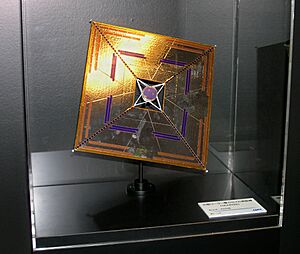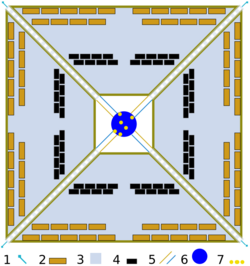IKAROS facts for kids

A 1:64 scale model of the 14 m × 14 m (46 ft × 46 ft) sized IKAROS spacecraft
|
|
| Mission type | Solar sail technology |
|---|---|
| Operator | JAXA |
| Mission duration | 5 years launch to last contact in 2015 |
| Spacecraft properties | |
| Launch mass | 310 kg |
| Dimensions | Solar sail: 14 m × 14 m (46 ft × 46 ft) (area: 196 m2 (2,110 sq ft)) |
| Start of mission | |
| Launch date | 21:58:22, 20 May 2010 (UTC) |
| Rocket | H-IIA 202 |
| Launch site | Tanegashima, LA-Y |
| End of mission | |
| Last contact | 20 May 2015 |
| Orbital parameters | |
| Reference system | Heliocentric orbit |
| Flyby of Venus | |
| Closest approach | 8 December 2010 |
| Distance | 80,800 kilometers (50,200 mi) |
IKAROS (which stands for Interplanetary Kite-craft Accelerated by Radiation Of the Sun) is a special experimental spacecraft from the Japan Aerospace Exploration Agency. It was launched on May 20, 2010, on an H-IIA rocket. IKAROS traveled into space with the Akatsuki probe, which was heading to Venus, and four other small spacecraft.
IKAROS is famous because it was the first spacecraft to successfully use solar sail technology in space between planets. Its name comes from the old Greek story of Icarus. In the myth, Icarus flew too close to the Sun using wings made of feathers and wax.
On December 8, 2010, IKAROS flew past Venus. It was about 80,800 km (50,200 mi) away from the planet. This completed its main mission, and it then began an extended mission phase.
Contents
What IKAROS Was Built For
The IKAROS probe was the first spacecraft in the world to use a solar sail as its main way to move through space. It was designed to show that four important technologies could work:
- Deploying a large sail: It needed to unfold and control a very big, thin solar sail.
- Power from the sail: It used thin solar cells built right into the sail to power its systems.
- Measuring sunlight's push: It measured how much the Sun's light pushed on the sail. This push is called radiation pressure.
- Controlling direction: It controlled its direction in space by changing how reflective 80 special panels on the sail were. These panels used liquid crystal technology.
The mission also studied other things in space. These included gamma-ray bursts, the solar wind (particles from the Sun), and tiny bits of cosmic dust.
How the IKAROS Spacecraft Was Designed
The IKAROS spacecraft has a square sail. This sail unfolds by spinning, using four small weights at its corners. The sail is 20 m (66 ft) across from one corner to the opposite corner. It is made from a very thin sheet of polyimide, which is only 7.5 μm (0.00030 in) thick.
The sail itself weighed about 2 kilograms (4.4 lb). This does not include the corner weights, attached panels, or tethers. Thin solar cells are built into the sail to generate electricity. There are also 80 LCD panels on the sail. These panels can change how much light they reflect. This allows the spacecraft to control its direction in space. The sail also has eight dust counters on its other side to collect scientific data.
IKAROS Mission Journey
IKAROS was successfully launched on May 21, 2010. It lifted off from the Tanegashima Space Center in Japan. It launched with the Akatsuki probe, which was going to study Venus.
The IKAROS spacecraft spun at about 20 to 25 rotations per minute (rpm). It finished unfolding its large sail on June 10, 2010. The spacecraft also had two tiny cameras that it could release, called DCAM1 and DCAM2. One of these cameras, DCAM2, took pictures of the fully deployed sail on July 14, 2010.
Over the next six months, as IKAROS traveled towards Venus, its acceleration and direction control were tested. On July 9, 2010, JAXA confirmed that the solar sail was indeed pushing IKAROS forward. By July 23, they announced that the spacecraft could successfully control its direction. This was done by changing the reflectivity of the 80 liquid crystal panels on the sail's edge. This created a small push from sunlight that helped steer the spacecraft.
IKAROS continued to spin at about 2 rpm. The LCD panels had to be cycled at this speed to keep the spacecraft pointed correctly.
Extended Mission and Guinness World Records
JAXA announced that IKAROS finished all its planned experiments by December 2010. However, the mission continued to help scientists learn more about controlling a solar sail. On November 30, 2012, IKAROS was recognized by Guinness World Records. It became the world's first solar sail spacecraft to travel between planets. Its two small cameras, DCAM1 and DCAM2, were also recognized as the smallest spacecraft to fly between planets.
By 2012, IKAROS was still spinning, but its ability to control its direction was not as good. This caused the sail to move in unexpected ways. Because of this, communication with the spacecraft became difficult. The project team was officially closed on March 28, 2013.
However, the project was started again on June 20, 2013. Scientists hoped the satellite would "wake up" from a sleep-like state. This would happen when its solar panels got enough sunlight again. The team was able to receive data from IKAROS between June 20 and September 12, 2013. After that, contact was lost again. This was expected, as the spacecraft likely went back into a low-power sleep mode.
By August 2013, the solar sail had changed IKAROS's speed by about 400 metres per second (890 mph) in total.
Signals from IKAROS were received again on May 22, 2014. At this time, the spacecraft was about 230 million kilometers from Earth. By May 2014, IKAROS was orbiting the Sun every ten months. It spent about seven months of each orbit in a sleep mode because it didn't get enough power. By April 23, 2015, the spacecraft woke up for the fourth time. It was about 120 million kilometers from Earth.
On May 21, 2015, JAXA could no longer receive a signal from IKAROS. They believed the spacecraft had gone into its fifth sleep mode, as predicted. The last data from May 2015 showed IKAROS was about 110 million kilometers from Earth and 130 million kilometers from the Sun.
Scientific Discoveries
One of the scientific results from IKAROS was measuring the push from the Sun's light. JAXA scientists stated on July 9, 2010, that the force from solar radiation pressure on IKAROS's 196 square meter sail was 1.12 millinewtons. This small but constant push allowed the spacecraft to travel through space without traditional rocket fuel.
See also
- CubeSail
- CubeSail (UltraSail)
- LightSail 2
- List of missions to Venus
- Near-Earth Asteroid Scout
- NanoSail-D2
- OKEANOS



